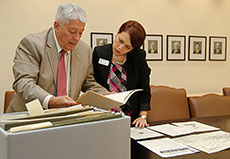News Release
Cuban Heritage Collection Acquires Brothers to the Rescue Archive
A search-and-rescue organization that saved thousands of Cuban rafters adrift in the Florida Straits has donated its extensive archives to the University of Miami’s Cuban Heritage Collection.
By Robert C. Jones Jr.
UM News
CORAL GABLES, Fla. (January 10, 2014) — Flying in their dependable, twin-engine Cessna 337s, the pilots of Brothers to the Rescue patrolled the skies over the Straits of Florida for more than a decade, searching for Cuban rafters adrift at sea and then alerting the U.S. Coast Guard to the migrants’ coordinates.
Hermanos al Rescate, as the organization was known in Spanish, flew hundreds of missions and helped rescue thousands of men, women, and children from 1991 to 2003. But when the Coast Guard began returning all refugees intercepted at sea to Cuba and the fleeing migrants began relying on speedboats operated by smugglers to reach the U.S., fewer and fewer rafters were spotted at sea, forcing Brothers to the Rescue to halt its search-and-rescue missions.
The organization’s history, however, lives on in a trove of archival materials recently donated to the University of Miami Libraries’ Cuban Heritage Collection (CHC). Stored in more than 60 boxes, the records include documents, photographs, press clippings, flight recordings, logs of the pilots’ missions, forms reporting rafter sightings, and leaflets dropped by aviators from their planes.
“I can’t think of any other better place [to house the collection],” José Basulto, the pilot who co-founded and led the volunteer group, said Thursday at a reception held inside the CHC’s Goizueta Pavilion to announce the acquisition and honor the group’s members.
He and other Brothers to the Rescue entrusted the CHC with their legacy “because they understand the importance of preserving their history so that it will forever be a part of the history we all share,” said Maria Estorino, the Esperanza Bravo de Varona Chair of the Cuban Heritage Collection. Scholars conducting research on the organization and its activities, aviation buffs, and students studying immigration and Cuba’s past are among those Estorino envisions using the collection.
After rescue flights stopped in 2003, the records were moved from the group’s headquarters to a small warehouse, where they remained until Basulto and his wife, Rita, brought them to their Miami home. Former CHC chair de Varona and Estorino had long hoped to bring the collection to the Cuban Heritage Collection. Late last year, Basulto finally called Estorino, telling her he was ready to donate the items. The gift is part of Momentum2: The Breakthrough Campaign for the University of Miami.
Among the archive’s important pieces: a dossier on the fatal flight of the two Brothers to the Rescue aircraft shot down by a Cuban MIG fighter jet on February 24, 1996, resulting in the deaths of four pilots.
“Our hearts are with them today,” said Basulto.
It was Basulto, who earned a degree in architectural engineering from UM in 1969, and longtime friend Billy Schuss who came up with the idea for Brothers to the Rescue. Schuss, after seeing the newscast of 15-year-old rafter Gregorio Perez, who died of severe dehydration in the arms of a U.S. Coast Guard officer only eight miles from land, came to Basulto and said something needed to be done.
“Billy wanted to organize boat missions off the Keys [where many of the rafters would come ashore]. But I told him there was no way we’d find anyone looking at the horizon from a boat. At the time, I had an airplane, so I said, ‘Maybe from a plane.” So Basulto started formulating a plan, determining what they’d need to pull off the missions. “What we needed was the ability to see rafters, zero in on their location, and communicate their position to the rescuers,” he said.
Eventually, he recruited other pilots, whose planes were equipped with Loran-C transmitters, a ground-based navigation system operated by the Coast Guard. They also used some of the earliest cellphones to communicate, some of them, Basulto exaggerated, as big as suitcases.
At its height the group conducted 32 weekly missions, he said.
Many of the pilots attended Thursday’s ceremony, including Mayte Greco, the first female aviator to fly for Brothers to the Rescue. During their initial flights, she said, they realized they needed to make the missions safer and increase the chances of locating rafters. “We started wearing life jackets and bringing flares. We started a buddy system, flying two aircraft. Then we added co-pilots, observers who would scan the sea. Now we had four sets of eyes on the ocean and we could see more,” said Greco, a 1982 UM graduate.
Had she not been participating in an interview with a Smithsonian writer doing a story on women in flight on the fateful day when Cuban MiGs shot down the Brothers to the Rescue planes, Greco might not be here today. “Jose [Basulto] put Pablo [Morales] and Mario [de la Peña] in what would have been my airplane,” she said, referring to two of the four men killed.
She said the donated archive is more than a collection of documents. “It shows the history and story of people who would risk their lives on an inner tube to find a better life,” she said. “It shows their history, what they’ve gone through, and what communism has done.”
Robert C. Jones Jr. can be reached at 305-284-1615.
